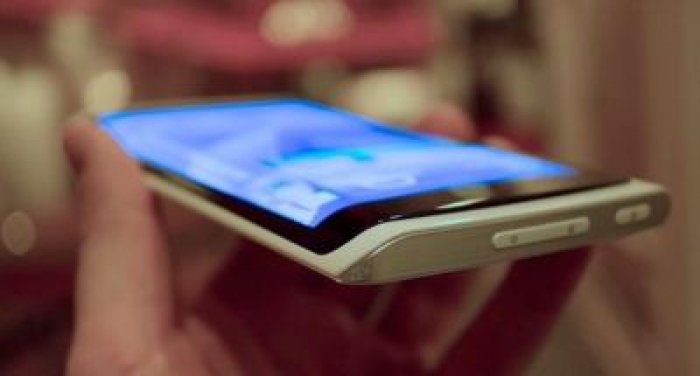The Galaxy S5 and Curved Displays
The Samsung Galaxy S5, released in 2014, was a significant smartphone release, but it did not feature a curved display. While rumors swirled about the possibility of a curved screen on the S5, Samsung ultimately opted for a traditional flat display. This decision was likely influenced by a combination of factors, including the nascent state of curved display technology and the potential challenges in implementing it on a mass-produced device.
The History of Samsung’s Curved Display Technology
Samsung’s journey with curved displays began in 2013 with the launch of the Galaxy Round, a smartphone featuring a slightly curved display. This innovative device was a stepping stone for Samsung, showcasing its capabilities in producing curved screens. However, the Galaxy Round was not a commercial success, possibly due to its high price and limited availability. The company continued its research and development efforts, leading to the launch of the Galaxy Note Edge in 2014, which featured a curved display on one side of the screen. This model was more successful than the Galaxy Round, indicating a growing interest in curved displays.
Rumors Surrounding the Galaxy S5 and Curved Displays
Prior to the release of the Galaxy S5, numerous rumors circulated about the potential inclusion of a curved display on the device. Some reports claimed that Samsung was working on a curved display variant of the S5, possibly with a design similar to the Galaxy Round. However, these rumors ultimately proved to be false. The Galaxy S5, in its final form, featured a traditional flat display.
Reasons for Considering a Curved Display for the Galaxy S5
Several factors might have prompted Samsung to consider a curved display for the Galaxy S5. The technology had the potential to offer several advantages, including:
- Enhanced Viewing Experience: Curved displays could provide a more immersive viewing experience, particularly for multimedia content such as movies and games. The curved screen could wrap around the user’s field of vision, creating a more cinematic effect.
- Improved Ergonomics: A curved display could offer a more comfortable grip, especially for larger smartphones. The curved shape could conform to the natural curve of the hand, making the device feel more ergonomic.
- Unique Design: Curved displays could provide a distinct design element, differentiating Samsung’s devices from the competition. The curved shape could add a premium feel and a more futuristic aesthetic.
Technical Challenges of Implementing a Curved Display on the Galaxy S5
While the potential benefits of a curved display were enticing, Samsung likely faced several technical challenges in implementing it on the Galaxy S5. These challenges could have included:
- Production Complexity: Manufacturing curved displays was a complex process, requiring specialized equipment and techniques. Mass production of curved displays on a scale necessary for a flagship smartphone like the Galaxy S5 might have been challenging at the time.
- Durability: Curved displays were more susceptible to damage than traditional flat displays. Ensuring the durability of a curved display on a device like the Galaxy S5, which was expected to be subjected to everyday wear and tear, could have been a significant challenge.
- Software Optimization: Curved displays required software optimization to take advantage of their unique shape and form factor. Developing software that could effectively utilize the curved screen for various applications and user interfaces might have been a significant hurdle.
Market Trends and Consumer Expectations
The release of the Samsung Galaxy S5 in 2014 coincided with a growing interest in curved displays within the smartphone market. While curved displays were not entirely new, their adoption was gaining momentum, fueled by advancements in display technology and a desire among manufacturers to offer unique and innovative features. This section will delve into the market trends and consumer expectations surrounding curved displays during that period, exploring their potential advantages and disadvantages, and analyzing the Galaxy S5’s position in the market.
Market Trends and Consumer Expectations Regarding Curved Displays
Around the time of the Galaxy S5’s release, curved displays were primarily seen as a premium feature, often associated with high-end flagship devices. Manufacturers like Samsung, LG, and even some Chinese brands were experimenting with curved displays, viewing them as a way to differentiate their products and appeal to consumers seeking cutting-edge technology. The trend was fueled by the growing popularity of large-screen smartphones, with curved displays offering a more immersive and ergonomic experience, especially for media consumption.
Advantages and Disadvantages of Curved Displays
Curved displays offered several advantages over traditional flat displays, particularly in terms of aesthetics and user experience. The curved design allowed for a more immersive viewing experience, wrapping around the user’s field of vision, and creating a sense of depth. This was especially beneficial for watching movies, playing games, and browsing the web. Furthermore, curved displays could be designed to be more ergonomic, fitting comfortably in the hand and reducing the likelihood of accidental touches.
However, curved displays also came with their own set of disadvantages. The production process for curved displays was more complex and expensive than for flat displays, leading to higher manufacturing costs. Additionally, curved displays were more susceptible to damage, particularly scratches and cracks, due to their non-uniform surface. The curved design could also make it more challenging to find protective cases and screen protectors.
Galaxy S5 vs. Other Flagship Smartphones
The Galaxy S5, while a highly anticipated device, did not feature a curved display. Instead, it opted for a traditional flat display, albeit with a high-resolution Super AMOLED screen. This decision was likely influenced by the relatively nascent state of curved display technology and the associated cost considerations. Other flagship smartphones released around the same time, like the LG G Flex, embraced curved displays, positioning themselves as pioneers in this emerging trend.
Impact of Curved Displays on the Galaxy S5’s Perceived Innovation
The absence of a curved display on the Galaxy S5 could have potentially impacted its perceived innovation and desirability among consumers. While the Galaxy S5 offered a robust set of features and specifications, including a powerful processor, a high-resolution camera, and a water-resistant design, the lack of a curved display might have made it appear less cutting-edge compared to competitors like the LG G Flex. However, it’s important to note that the Galaxy S5’s success wasn’t solely dependent on having a curved display. Its strong brand recognition, its comprehensive feature set, and its competitive pricing contributed significantly to its market performance.
Samsung’s Strategy and Decision-Making: Samsung Galaxy S5 Will Not Featured Curved Display Rumor
Samsung’s product development strategy is a complex interplay of innovation, market trends, and consumer expectations. The company aims to push the boundaries of mobile technology while catering to a diverse user base. Their approach involves a careful balance of introducing cutting-edge features while maintaining a level of familiarity that ensures user comfort.
Factors Influencing the Decision to Omit Curved Displays
Several factors likely contributed to Samsung’s decision to exclude curved displays on the Galaxy S5. The technology was still in its early stages, with manufacturing challenges and high production costs. Furthermore, the market for curved displays was not yet fully established, and consumer demand for this feature was uncertain. Samsung likely prioritized proven technologies and features that would appeal to a broader audience.
Manufacturing Costs and Production Feasibility
At the time of the Galaxy S5 release, curved displays were a relatively new technology with significant manufacturing challenges. The process involved complex and expensive equipment, leading to higher production costs. Yield rates were also lower compared to traditional flat displays, further contributing to the cost burden. Samsung likely assessed that the benefits of incorporating curved displays did not outweigh the risks associated with high costs and potential manufacturing issues.
Risks and Rewards of Introducing Curved Displays
Introducing a new technology like curved displays on a flagship device carries both risks and rewards. On the one hand, it could create a significant buzz and attract attention from tech enthusiasts and early adopters. On the other hand, there were concerns about potential manufacturing issues, higher costs, and the possibility of consumer resistance to a novel feature. Samsung, being a cautious and strategic company, likely decided to wait for the technology to mature and consumer demand to solidify before incorporating it into its flagship device.
Impact on the Galaxy S5 and Subsequent Models
The Galaxy S5’s decision to forgo a curved display, despite its burgeoning popularity, was a strategic gamble by Samsung. This decision had a significant impact on the Galaxy S5’s reception and sales, and it ultimately influenced the direction of future Galaxy models.
The Galaxy S5’s Reception and Sales
The Galaxy S5, while a strong performer, didn’t quite reach the sales heights of its predecessors. The lack of a curved display, a feature increasingly associated with premium smartphones, might have contributed to this. Consumers, accustomed to Samsung’s innovative spirit, were perhaps expecting a more cutting-edge design. The Galaxy S5’s sales were also impacted by the rise of other Android manufacturers, particularly Chinese brands, who were offering competitive devices at lower price points.
Influence on Subsequent Galaxy Models, Samsung galaxy s5 will not featured curved display rumor
Samsung’s decision to not include a curved display on the Galaxy S5 marked a turning point in the company’s approach to design. The subsequent Galaxy S6, released in 2015, featured a dual-curved display, signaling a shift towards more innovative and visually appealing designs. This shift was further emphasized with the Galaxy Note Edge, which featured a curved display on one side of the device.
Comparison with Successors
The Galaxy S5’s design, while functional, was considered rather conservative compared to its successors. The Galaxy S6 and its subsequent iterations, like the Galaxy S7 and S8, embraced a more premium and visually striking design language, characterized by curved displays, metal frames, and sleek aesthetics. This evolution in design mirrored the increasing consumer demand for visually appealing and innovative smartphones.
Impact on Market Position and Competition
The introduction of curved displays in later Galaxy models played a crucial role in maintaining Samsung’s market position. The unique and visually captivating design of the Galaxy S6 and its successors helped differentiate them from competitors. Samsung’s early adoption of curved display technology, a feature that was initially considered a niche innovation, cemented its position as a leader in smartphone design and innovation.
Samsung galaxy s5 will not featured curved display rumor – The Galaxy S5’s lack of a curved display ultimately didn’t hinder its success. It was still a top-selling device, praised for its performance and features. However, the decision not to include a curved display was a turning point. It marked a period of cautious innovation for Samsung, as they focused on refining their existing technologies and gauging the market’s readiness for new concepts. The following years saw Samsung gradually introduce curved displays into its Galaxy line, culminating in the iconic Galaxy S6 Edge and its successors. The Galaxy S5, in retrospect, became a bridge between traditional smartphone design and the future of curved displays, paving the way for a new era of mobile aesthetics and functionality.
While the Samsung Galaxy S5 might not be rocking a curved display, there’s still plenty to be excited about with its Android 8.1 Oreo update. This update brings a ton of new features, including Picture-in-Picture (PiP) mode for apps like Netflix, which lets you watch your favorite shows while multitasking. So, even without a curved screen, the Galaxy S5 can still keep up with the latest tech trends.
 Standi Techno News
Standi Techno News

